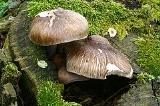
Pluteaceae
Encyclopedia
The Pluteaceae are a family
of small to medium-sized mushrooms which have free gill attachment and pink spore
s. Members of Pluteaceae can be mistaken for members of Entolomatacae but can be distinguished by their angled spores and attached gills. The four genera in the Pluteaceae include the widely distributed Volvariella
and Pluteus
, the rare Chamaeota
, and Volvopluteus
, newly described in 2011 as a result of molecular analysis. The Dictionary of the Fungi (10th edition, 2008) estimates there are 364 species in the family.
Family (biology)
In biological classification, family is* a taxonomic rank. Other well-known ranks are life, domain, kingdom, phylum, class, order, genus, and species, with family fitting between order and genus. As for the other well-known ranks, there is the option of an immediately lower rank, indicated by the...
of small to medium-sized mushrooms which have free gill attachment and pink spore
Spore
In biology, a spore is a reproductive structure that is adapted for dispersal and surviving for extended periods of time in unfavorable conditions. Spores form part of the life cycles of many bacteria, plants, algae, fungi and some protozoa. According to scientist Dr...
s. Members of Pluteaceae can be mistaken for members of Entolomatacae but can be distinguished by their angled spores and attached gills. The four genera in the Pluteaceae include the widely distributed Volvariella
Volvariella
Volvariella is a genus of mushrooms with deep salmon pink gills and spore prints. They lack a ring, and have an Amanita-like volva at the stem base. Some species of Amanita look similar, but Amanita has white spores and often have a ring. Since the gills of young Volvariella are white at first,...
and Pluteus
Pluteus
Pluteus is a large genus of fungi with over 100 species. They are wood rotting saprobes with pink spore prints and gills that are free from the stem.Pluteus means shed or penthouse.-Characteristics of the genus :...
, the rare Chamaeota
Chamaeota
Chamaeota is a genus in the Pluteaceae family of small to medium sized mushrooms. They have a central stem, free gills, smooth pink spores, and a partial veil that usually forms an annulus on the stalk. Chamaeota can be distinguished from Volvariella by its lack of a volva and from...
, and Volvopluteus
Volvopluteus
Volvopluteus is a genus in the Pluteaceae family. It was circumscribed in 2011 as a result of molecular analysis....
, newly described in 2011 as a result of molecular analysis. The Dictionary of the Fungi (10th edition, 2008) estimates there are 364 species in the family.
Selected species
- Pluteus cervinusPluteus cervinusPluteus cervinus, also known as Pluteus atricapillus and commonly known as the deer shield or the deer or fawn mushroom, is a mushroom that belongs to the large genus Pluteus. It is found on rotten logs, roots and tree stumps and is widely distributed. It can also grow on sawdust and other wood...
, synonym Pluteus atricapillus, or Deer mushroom - Pluteus concentricus
- Pluteus leoninusPluteus leoninusPluteus leoninus, commonly known as Lion Shield, can occasionally be found growing on dead wood in Europe and North Africa. The underside of the cap is typical of the genus Pluteus — the gills are pale, soon becoming pink when the spores ripen. But the upper surface is a bright tawny or...
- Pluteus murinus
- Volvariella speciosa
- Volvariella volvaceaVolvariella volvaceaVolvariella volvacea is a species of edible mushroom cultivated throughout East and Southeast Asia and used extensively in Asian cuisines. In Chinese, they are called cǎogū Volvariella volvacea (also known as straw mushroom or paddy straw mushroom; syn. Volvaria volvacea, Agaricus volvaceus,...

